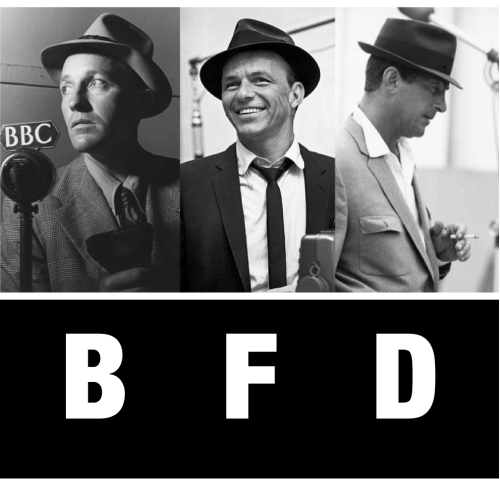 BING, FRANK & DEAN are a BFD.
BING, FRANK & DEAN are a BFD.
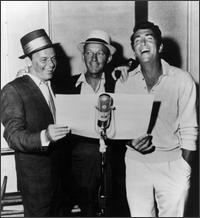 Bing Crosby, Frank Sinatra and Dean Martin dominated the American popular music landscape from the Jazz Age to the Rock & Roll Revolution of the 50’s. Listening to this collection of tunes (see below), it’s abundantly clear that in the mid-1920’s Bing was already plugged into black American jazz and rhythm and blues in the same way that Elvis Presley would later synthesize those same black influences – along with everything he learned from Bing, Frank (and in particular) Dean.
Bing Crosby, Frank Sinatra and Dean Martin dominated the American popular music landscape from the Jazz Age to the Rock & Roll Revolution of the 50’s. Listening to this collection of tunes (see below), it’s abundantly clear that in the mid-1920’s Bing was already plugged into black American jazz and rhythm and blues in the same way that Elvis Presley would later synthesize those same black influences – along with everything he learned from Bing, Frank (and in particular) Dean.
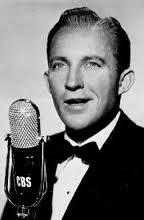 Among 20th century singers, a case can be made that Bing is King. The development of the microphone made Bing’s vocal style possible. At a time when vaudeville singers like Al Jolson and Eddie Cantor were still belting it out to sing over the band, Bing caressed the microphone and used it to his advantage. Bing put a song across in deep, subtle, and dynamic ways that would not have been possible without electric amplification. Bing’s jazzy, relaxed and sophisticated vocal style influenced every pop, rock and jazz singer that followed – whether they knew it or not.
Among 20th century singers, a case can be made that Bing is King. The development of the microphone made Bing’s vocal style possible. At a time when vaudeville singers like Al Jolson and Eddie Cantor were still belting it out to sing over the band, Bing caressed the microphone and used it to his advantage. Bing put a song across in deep, subtle, and dynamic ways that would not have been possible without electric amplification. Bing’s jazzy, relaxed and sophisticated vocal style influenced every pop, rock and jazz singer that followed – whether they knew it or not.
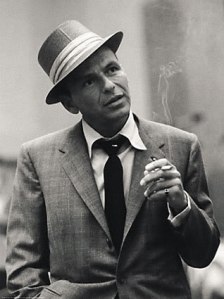 I thank my friend Dana for hipping me to Frank Sinatra back in our days at Northwestern University. In fact, the only song played on Dana’s Hi-Fi as often Bruce Springsteen’s “Born to Run” was Sinatra’s “Come Fly With Me.”
I thank my friend Dana for hipping me to Frank Sinatra back in our days at Northwestern University. In fact, the only song played on Dana’s Hi-Fi as often Bruce Springsteen’s “Born to Run” was Sinatra’s “Come Fly With Me.”
My resistance to Sinatra owed a lot to politics and Sinatra’s uneasy reaction to rock and roll. But I should’ve known better than to reject one of the great vocal stylists in popular music history — and a champion of great songwriters.
Elvis Presley, the King of Rock & Roll, was smarter than that.
 Young Elvis was a big Dean Martin fan. Of course, he was. Dean was the epitome of cool – and Dean’s smooth, effortless, yet exciting style – with his signature, sexy dynamics and boozy note bending became part of Elvis’ vocal arsenal as well. I hear a ton of Dean on Elvis cuts like “Love Me Tender” and “Are You Lonesome Tonight?”
Young Elvis was a big Dean Martin fan. Of course, he was. Dean was the epitome of cool – and Dean’s smooth, effortless, yet exciting style – with his signature, sexy dynamics and boozy note bending became part of Elvis’ vocal arsenal as well. I hear a ton of Dean on Elvis cuts like “Love Me Tender” and “Are You Lonesome Tonight?”
All right, let’s get to the songs. Too bad nobody has a Hi-Fi anymore – because that’s how this music should be appreciated — with a mixed drink in hand, sharing it with your favorite girl. And/or your kids. It’s a BFD.
Click on the links below the song titles to hear the tunes.
1. Some of These Days (Bing)
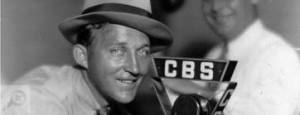 This record is often cited as a prime example of Bing Crosby’s ability to sing jazz. In 1932, Bing recorded his take on this Shelton Brooks song written in 1910 specifically for Sophie Tucker. Bing is backed on this cut by the Lennie Hayton orchestra, featuring a great solo by Crosby favorite Eddie Lang. Listening to Bing swing in front of a classic jazz band, you can easily imagine this tune coming up with the credits after an episode of “Boardwalk Empire”. Bing was at home in front of bands of all sizes and styles. He cut his teeth with jazz bands in the 20’s before becoming a fixture of swing bands in the 30’s. These bands were all about dance music – and Bing knew his role, always giving the band’s players plenty of space to solo, rock and wail.
This record is often cited as a prime example of Bing Crosby’s ability to sing jazz. In 1932, Bing recorded his take on this Shelton Brooks song written in 1910 specifically for Sophie Tucker. Bing is backed on this cut by the Lennie Hayton orchestra, featuring a great solo by Crosby favorite Eddie Lang. Listening to Bing swing in front of a classic jazz band, you can easily imagine this tune coming up with the credits after an episode of “Boardwalk Empire”. Bing was at home in front of bands of all sizes and styles. He cut his teeth with jazz bands in the 20’s before becoming a fixture of swing bands in the 30’s. These bands were all about dance music – and Bing knew his role, always giving the band’s players plenty of space to solo, rock and wail.
In Bing’s early days, dance bands didn’t always employ a vocalist. In fact, when Bing began singing with Paul Whiteman’s band, he was required to sit holding a dummy instrument so as not to look odd to the audience. By the time Frank Sinatra came along, it had recently become the fashion for bands to feature a regular vocalist. And the vocalists, and not the bandleaders, eventually became the stars. As usual, Bing was a trailblazer. Bandleader Tommy Dorsey told Sinatra that the one singer he should listen to was Bing Crosby. Duh. As a kid, Frank had a picture of Bing taped above his bed.
“Sure, I’m a Crosby fan. Everybody’s a Crosby fan.”
Frank Sinatra
2. Stormy Weather (Frank)
“Frank Sinatra is the kind of singer who comes along once in a lifetime.
But why did it have to be my lifetime?”
Bing Crosby
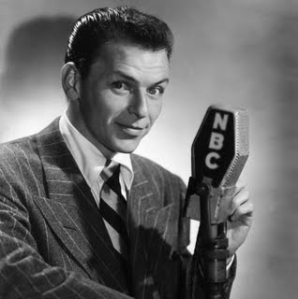 Frank cut this Harold Arlen & Ted Koehler tune in L.A. in 1947 for a special V-Disc for the occupation troops overseas. Frank made a lot of V-Discs during the war. Ironically, the man with such an ear for melody was kept out of the war by a perforated eardrum, causing him to be classified 4-F (“Registrant not acceptable for military service”) by his draft board in ‘43. An FBI report released in 1998 showed that the doctors had also noted that Frank was a “neurotic” and “not acceptable material from a psychiatric standpoint.” This was omitted from his record to avoid “undue unpleasantness for both the selectee and the induction service.”
Frank cut this Harold Arlen & Ted Koehler tune in L.A. in 1947 for a special V-Disc for the occupation troops overseas. Frank made a lot of V-Discs during the war. Ironically, the man with such an ear for melody was kept out of the war by a perforated eardrum, causing him to be classified 4-F (“Registrant not acceptable for military service”) by his draft board in ‘43. An FBI report released in 1998 showed that the doctors had also noted that Frank was a “neurotic” and “not acceptable material from a psychiatric standpoint.” This was omitted from his record to avoid “undue unpleasantness for both the selectee and the induction service.”
3. Memories Are Made Of This (Dean)
BTW — Dean was drafted into the army in 1944 and served a year in Akron, Ohio before being reclassified as 4-F and discharged, possibly because of a double hernia.
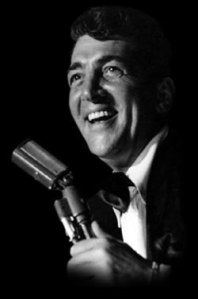 Now back to the music. On this recording, it’s easy to hear how Dean’s vocal style had such a profound effect on young Elvis Presley. Dean recorded “Memories Are Made Of This” with Dick Stabile and The Easy Riders. They cut the track on October 28, 1955 and it was released a month later. The record hit #1 on the charts on December 3rd — just a week after its release and less than two months after it was recorded. Those were the days, huh? Came you imagine a recording going from the studio to #1 in less than two months now? And this was at a time when Elvis was tearing up the charts. I love the stripped down instrumentation: just a guitar and an upright bass. Not even a drum. Totally cool. Totally relaxed. Totally Dean.
Now back to the music. On this recording, it’s easy to hear how Dean’s vocal style had such a profound effect on young Elvis Presley. Dean recorded “Memories Are Made Of This” with Dick Stabile and The Easy Riders. They cut the track on October 28, 1955 and it was released a month later. The record hit #1 on the charts on December 3rd — just a week after its release and less than two months after it was recorded. Those were the days, huh? Came you imagine a recording going from the studio to #1 in less than two months now? And this was at a time when Elvis was tearing up the charts. I love the stripped down instrumentation: just a guitar and an upright bass. Not even a drum. Totally cool. Totally relaxed. Totally Dean.
4. Shoo Shoo Baby (Bing)
 Written by Phil Moore, “Shoo Shoo Baby” was a big hit for The Andrews Sisters. Bing recorded this live version with a big band for an Armed Forces Broadcast during World War Two. By the 1940’s, Bing had already enjoyed more than two decades of success in the music industry. In 1926, fledgling crooner Bing was singing on the vaudeville circuit in L.A. when he came to the attention of one of the greatest bandleaders of the era, Paul Whiteman (a.k.a. The King of Jazz), who hired him to join one of the most popular bands in America. Unlike the typical vaudeville shouters, Bing learned to work the mic (and the crowd), drawing listeners in with his groovy, jazzy, mellow dynamics. But Bing was evidently a bit of a rock star in his early days – and Whiteman had to fire his star vocalist in 1930 due to his repeated youthful peccadilloes. Bada Bing, Bing.
Written by Phil Moore, “Shoo Shoo Baby” was a big hit for The Andrews Sisters. Bing recorded this live version with a big band for an Armed Forces Broadcast during World War Two. By the 1940’s, Bing had already enjoyed more than two decades of success in the music industry. In 1926, fledgling crooner Bing was singing on the vaudeville circuit in L.A. when he came to the attention of one of the greatest bandleaders of the era, Paul Whiteman (a.k.a. The King of Jazz), who hired him to join one of the most popular bands in America. Unlike the typical vaudeville shouters, Bing learned to work the mic (and the crowd), drawing listeners in with his groovy, jazzy, mellow dynamics. But Bing was evidently a bit of a rock star in his early days – and Whiteman had to fire his star vocalist in 1930 due to his repeated youthful peccadilloes. Bada Bing, Bing.
5. Ol’ Man River (Frank)
 This Jerome Kern/Oscar Hammerstein tune from the Broadway musical “Show Boat” was recorded by Frank on a CBS Radio Broadcast in Hollywood in April 1945 and included on a V-Disc sent to the troops in the last year of the war. By 1945, Frankmania was raging, with bobbysoxers swooning and throwing their underwear on stage during his gigs. In ‘44, his shows at the Paramount Theater in NYC sold out the 3,600 seats inside and left 30,000 fans outside dying to get in. As with Elvis and the Beatles, riots, hysteria and frenzied fandom drove a wedge between parents and their teenagers. Frank also sang the song in the 1945 film bio of Jerome Kern, “Till the Clouds Roll By”. Capitalizing on Frank’s appeal with teen audiences, the film included two versions of “Ol’ Man River” — the first a straightforward version sung by African-American actor-singer Caleb Peterson and the second a “crooner version” performed by Frank as the film’s grand finale. Trivia note: Bing’s 1928 recording of the song for Paul Whiteman’s band became his first #1 record as a vocalist.
This Jerome Kern/Oscar Hammerstein tune from the Broadway musical “Show Boat” was recorded by Frank on a CBS Radio Broadcast in Hollywood in April 1945 and included on a V-Disc sent to the troops in the last year of the war. By 1945, Frankmania was raging, with bobbysoxers swooning and throwing their underwear on stage during his gigs. In ‘44, his shows at the Paramount Theater in NYC sold out the 3,600 seats inside and left 30,000 fans outside dying to get in. As with Elvis and the Beatles, riots, hysteria and frenzied fandom drove a wedge between parents and their teenagers. Frank also sang the song in the 1945 film bio of Jerome Kern, “Till the Clouds Roll By”. Capitalizing on Frank’s appeal with teen audiences, the film included two versions of “Ol’ Man River” — the first a straightforward version sung by African-American actor-singer Caleb Peterson and the second a “crooner version” performed by Frank as the film’s grand finale. Trivia note: Bing’s 1928 recording of the song for Paul Whiteman’s band became his first #1 record as a vocalist.
6. You Was (Dean)
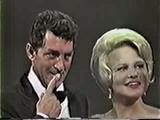 I love Dean’s playful duet with Peggy Lee on this song, written by Sonny Burke & Paul Francis Webster, and recorded on December 12, 1948. Who but Dean could deliver a lyric like “my heart is a spherical, lyrical miracle” with such easygoing self-assurance. (Dynamic moments like that – and performances like “Memories Are Made Of This” prove that Dean is the link between Bing and Elvis.) With his swinging playboy image, Dean was a master of the sexy male-female duet. If you dig this, check out Dean’s Christmas album classic, “Baby It’s Cold Outside”.
I love Dean’s playful duet with Peggy Lee on this song, written by Sonny Burke & Paul Francis Webster, and recorded on December 12, 1948. Who but Dean could deliver a lyric like “my heart is a spherical, lyrical miracle” with such easygoing self-assurance. (Dynamic moments like that – and performances like “Memories Are Made Of This” prove that Dean is the link between Bing and Elvis.) With his swinging playboy image, Dean was a master of the sexy male-female duet. If you dig this, check out Dean’s Christmas album classic, “Baby It’s Cold Outside”.
7. Pistol Packin’ Mama (Bing)
This 1943 recording by Bing and The Andrews Sisters was the first number record on the Juke Box Folk charts — followed onto the charts by the original version (recorded March 18, 1942) performed by Al Dexter, who also wrote the song.
8. Young At Heart (Frank)
Frank recorded this lovely, sentimental but swinging song, written by C. Leigh & J. Richards, for his 1953 album “This Is Sinatra”. Like so many classic Frank hits of the ‘50s, it was arranged and conducted by Nelson Riddle, who perfected the lush orchestrations that showcased Frank’s voice at the height of its power and subtlety.
9. Ain’t That A Kick In The Head (Dean)
If there’s a quintessential Rat Pack recording – this is it, baby! Composed in 1960 by Jimmy Van Heusen with lyrics by Sammy Cahn, “Ain’t That a Kick in the Head?” was recorded by Dean on May 10, 1960 with Nelson Riddle conducting the orchestra. Dean performed the song in the Rat Pack movie “Ocean’s 11”.
10. Brother, Can You Spare A Dime? (Bing)
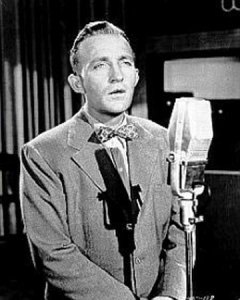 Along with “Ol Man River”, this powerful balled carries the sad but true tale of working men – black and white – from the 19th into the 20th century. Written in 1930 by lyricist E.Y. “Yip” Harburg and composer Jay Gorney, “Brother, Can You Spare a Dime?” became one of the most popular American songs of the Great Depression, best known through recordings by Bing and Rudy Vallee. Both versions were released right before Franklin Delano Roosevelt’s election to the presidency in 1932 and both records topped the charts. Bing’s recording became the best-selling record of its time: “an anthem of the shattered dreams of the era.”
Along with “Ol Man River”, this powerful balled carries the sad but true tale of working men – black and white – from the 19th into the 20th century. Written in 1930 by lyricist E.Y. “Yip” Harburg and composer Jay Gorney, “Brother, Can You Spare a Dime?” became one of the most popular American songs of the Great Depression, best known through recordings by Bing and Rudy Vallee. Both versions were released right before Franklin Delano Roosevelt’s election to the presidency in 1932 and both records topped the charts. Bing’s recording became the best-selling record of its time: “an anthem of the shattered dreams of the era.”
11. Where Or When (Frank)
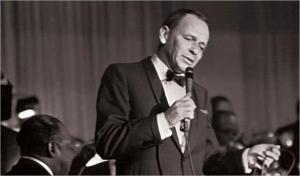 This recording captures Frank in concert in 1966 at The Sands in Las Vegas with Count Basie and The Orchestra — arranged and conducted by Quincy Jones. Is that enough talent in one room? Frank originally recorded the song for his dark 1958 concept album “Only The Lonely”, a collection of songs that convey heartbreak and urban isolation with a moody film noir feel, including “One For My Baby” which closes out this post.
This recording captures Frank in concert in 1966 at The Sands in Las Vegas with Count Basie and The Orchestra — arranged and conducted by Quincy Jones. Is that enough talent in one room? Frank originally recorded the song for his dark 1958 concept album “Only The Lonely”, a collection of songs that convey heartbreak and urban isolation with a moody film noir feel, including “One For My Baby” which closes out this post.
12. Open Up The Doghouse (Dean)
 This one’s nothing but sheer, exuberant, naughty fun – if you can get past the utterly non-PC last verse. Dean recorded this song, written by R. Alfred & M. Fisher as a live duet with Nat King Cole, on September 7, 1954 with Billy May and Orchestra, arranged by Nelson Riddle. When I interviewed the great Wrecking Crew guitarist Glen Campbell for “Behind The Music”, he told me that when he played sessions for Dean at Capitol Records, Dean would show up after the band had rehearsed the tracks and knock his performances out quickly in front of a partying crowd of friends and entourage in the studio. Dean loved a live feel and came alive in front of an audience – and he liked to capture that vibe in the studio.
This one’s nothing but sheer, exuberant, naughty fun – if you can get past the utterly non-PC last verse. Dean recorded this song, written by R. Alfred & M. Fisher as a live duet with Nat King Cole, on September 7, 1954 with Billy May and Orchestra, arranged by Nelson Riddle. When I interviewed the great Wrecking Crew guitarist Glen Campbell for “Behind The Music”, he told me that when he played sessions for Dean at Capitol Records, Dean would show up after the band had rehearsed the tracks and knock his performances out quickly in front of a partying crowd of friends and entourage in the studio. Dean loved a live feel and came alive in front of an audience – and he liked to capture that vibe in the studio.
13. After You’ve Gone (Bing)
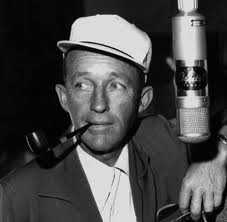 Bing’s enduring image as a softhearted movie priest and Christmas special crooner has unfortunately overshadowed his trailblazing work as a jazz cat. Bing’s 1946 single “After You’ve Gone” is one of his lesser-known records — but it puts to rest any notion that Bing was a square. The track is drenched in New Orleans/Dixieland jump and jive. The song, written in 1918 by Turner Layton with lyrics by Henry Creamer, had been covered many times before Bing cut this version with Eddie Condon & His Orchestra (with new lyrics by Eddie Condon). It was later included on Bings’s 1951 album, “Bing Crosby & Some Jazz Friends”. Bing’s jazz friends on this track include Eddie Condon (guitar), Bud Freeman (tenor saxophone), Joe Dixon (clarinet), Wild Bill Davison (cornet), Bob Haggart (bass) and George Wettling (drums).
Bing’s enduring image as a softhearted movie priest and Christmas special crooner has unfortunately overshadowed his trailblazing work as a jazz cat. Bing’s 1946 single “After You’ve Gone” is one of his lesser-known records — but it puts to rest any notion that Bing was a square. The track is drenched in New Orleans/Dixieland jump and jive. The song, written in 1918 by Turner Layton with lyrics by Henry Creamer, had been covered many times before Bing cut this version with Eddie Condon & His Orchestra (with new lyrics by Eddie Condon). It was later included on Bings’s 1951 album, “Bing Crosby & Some Jazz Friends”. Bing’s jazz friends on this track include Eddie Condon (guitar), Bud Freeman (tenor saxophone), Joe Dixon (clarinet), Wild Bill Davison (cornet), Bob Haggart (bass) and George Wettling (drums).
14. Come Fly With Me (Frank)
Here’s the song Dana Olsen introduced me to all those years ago, written by James Van Heusen & Sammy Cahn, arranged and conducted by Billy May for Frank’s 1957 album, “Come Fly With Me”. This is Frank and his groovy, hipster best. Martini anyone?
15. I’d Cry Like A Baby (Dean)
Dean recorded this easygoing yet plaintive S. Gallop & H. Steiner song on August 13, 1953 with Dick Stabile and Orchestra, arranged by Nelson Riddle. Cool, casual, groovy.
16. Now You Has Jazz (Bing)
Cole Porter wrote this song for the 1956 film “High Society” (which co-starred Bing and Frank), where it was introduced by Bing and Louis Armstrong and his band. Name a prominent singer or bandleader — and chances are that Bing worked with them at one time or another during his long career. Bing was the Great Collaborator.
17. In The Wee Small Hours Of The Morning (Frank)
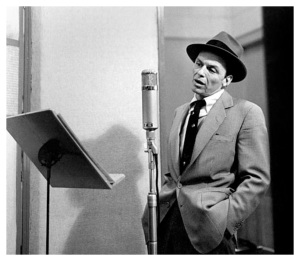 I just love this song, written by Bob Hilliard & Dave Mann. It’s one of my very favorite Frank tracks, arranged and conducted by Nelson Riddle for Frank’s 1955 album of the same name. The albums that Frank made with Nelson Riddle comprise the apex of his recording career: Songs for Young Lovers, Swing Easy, In the Wee Small Hours, Songs for Swingin’ Lovers and Only the Lonely. Frank’s interpretations of the songs on these albums are so definitive that anyone who tried to cover these songs after him had to either consciously avoid sounding anything like Frank or give up and call their version a tribute. The singers who came before Frank, including Bing, found their interpretations erased from popular memory. Today’s best crooners, like Michael Bublé and Harry Connick, Jr. still can’t get out from under the weight of Frank’s indelible stylistic stamp.
I just love this song, written by Bob Hilliard & Dave Mann. It’s one of my very favorite Frank tracks, arranged and conducted by Nelson Riddle for Frank’s 1955 album of the same name. The albums that Frank made with Nelson Riddle comprise the apex of his recording career: Songs for Young Lovers, Swing Easy, In the Wee Small Hours, Songs for Swingin’ Lovers and Only the Lonely. Frank’s interpretations of the songs on these albums are so definitive that anyone who tried to cover these songs after him had to either consciously avoid sounding anything like Frank or give up and call their version a tribute. The singers who came before Frank, including Bing, found their interpretations erased from popular memory. Today’s best crooners, like Michael Bublé and Harry Connick, Jr. still can’t get out from under the weight of Frank’s indelible stylistic stamp.
18. You Belong To Me (Dean)
 This is the suave, romantic Dino that every Italian-American woman in St. Rocco’s parish swooned over when his hits were played over the PA system during our annual Labor Day festival. Dean recorded this tune on June 12, 1952 with Dick Stabile and Orchestra, featuring Stabile on alto sax. Released only as a single, Dean’s recording reached #12 on the charts on September 6, 1952 – but it was still a hit at St. Rocco’s in the 60’s when I was a kid growing up. Of course, Dean and Frank were both Italian.
This is the suave, romantic Dino that every Italian-American woman in St. Rocco’s parish swooned over when his hits were played over the PA system during our annual Labor Day festival. Dean recorded this tune on June 12, 1952 with Dick Stabile and Orchestra, featuring Stabile on alto sax. Released only as a single, Dean’s recording reached #12 on the charts on September 6, 1952 – but it was still a hit at St. Rocco’s in the 60’s when I was a kid growing up. Of course, Dean and Frank were both Italian.
19. I’m Gonna Sit Right Down And Write Myself A Letter (Bing)
 Written in 1935 by Fred E. Ahlert with lyrics by Joe Young, this is the song from which Sir Paul got the phrase “kisses on the bottom” for the title of his 2012 album. Bing recorded it for “Bing With a Beat” — his 1957 concept album featuring “hot” jazz and Dixieland arrangements by Matty Matlock, played by Bob Scobey’s Frisco Jazz Band. Which leads to a second Beatles connection. In a TV interview on the 20th anniversary of John Lennon’s passing, John’s friend Elliot Mintz referred to this album while talking about John’s interest in Bing’s music. According to Mintz, “Yoko gave him this old-fashioned jukebox and John stocked it with Bing Crosby records. People kind of expected him to have rock ‘n’ roll records in there, but it was almost totally Crosby stuff. There were three songs which John played over and over. I still remember them. They were Crosby with a jazz quartet from the ’50s, I think. He would banter and talk in the songs and John thought that was just the end. The songs were “Whispering”, “I’m Gonna Sit Right Down and Write Myself a Letter”, and “Dream a Little Dream of Me”. Yeah, those were the songs, I can still see John listening to them.”
Written in 1935 by Fred E. Ahlert with lyrics by Joe Young, this is the song from which Sir Paul got the phrase “kisses on the bottom” for the title of his 2012 album. Bing recorded it for “Bing With a Beat” — his 1957 concept album featuring “hot” jazz and Dixieland arrangements by Matty Matlock, played by Bob Scobey’s Frisco Jazz Band. Which leads to a second Beatles connection. In a TV interview on the 20th anniversary of John Lennon’s passing, John’s friend Elliot Mintz referred to this album while talking about John’s interest in Bing’s music. According to Mintz, “Yoko gave him this old-fashioned jukebox and John stocked it with Bing Crosby records. People kind of expected him to have rock ‘n’ roll records in there, but it was almost totally Crosby stuff. There were three songs which John played over and over. I still remember them. They were Crosby with a jazz quartet from the ’50s, I think. He would banter and talk in the songs and John thought that was just the end. The songs were “Whispering”, “I’m Gonna Sit Right Down and Write Myself a Letter”, and “Dream a Little Dream of Me”. Yeah, those were the songs, I can still see John listening to them.”
(Note: I checked to make sure, and yep – all three of those songs are on “Bing With a Beat”.)
20. I’ve Got The World On A String (Frank)
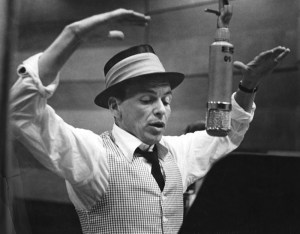 Written by Harold Arlen & Ted Koeler and recorded on April 30, 1953 for the album “This Is Sinatra”, this song is Frank’s first pairing with arranger and conductor Nelson Riddle. Riddle kept the band out of Frank’s way and used bass, reeds and horns to underscore and punctuate Frank’s phrasing. Working with Riddle, Frank honed his vocal style, connecting more with the emotional demands of each song and developing a self-assurance that allowed him to play with the melody and even change the songwriter’s words on occasion if it felt right. All of this is evident on “I’ve Got the World on a String.” Riddle opens with a big orchestral splash that quickly fades, leaving Frank to deliver the opening lines with spare accompaniment. Then – bang – the band jumps back in! And Riddle uses the drums in a way that seems to anticipate Rock & Roll’s backbeat. It’s a bold, dramatic start to one of the most successful collaborations in popular music.
Written by Harold Arlen & Ted Koeler and recorded on April 30, 1953 for the album “This Is Sinatra”, this song is Frank’s first pairing with arranger and conductor Nelson Riddle. Riddle kept the band out of Frank’s way and used bass, reeds and horns to underscore and punctuate Frank’s phrasing. Working with Riddle, Frank honed his vocal style, connecting more with the emotional demands of each song and developing a self-assurance that allowed him to play with the melody and even change the songwriter’s words on occasion if it felt right. All of this is evident on “I’ve Got the World on a String.” Riddle opens with a big orchestral splash that quickly fades, leaving Frank to deliver the opening lines with spare accompaniment. Then – bang – the band jumps back in! And Riddle uses the drums in a way that seems to anticipate Rock & Roll’s backbeat. It’s a bold, dramatic start to one of the most successful collaborations in popular music.
21. Just In Time (Dean)
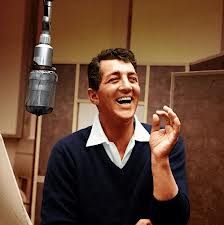 Dean recorded this song, with melody by Jule Styne and lyrics by Comden & Green, on May 17, 1960 for his album “This Time I’m Swingin”. The orchestra conducted by – who else? — Nelson Riddle. Judy Holliday and Dean sang the song in the 1960 film, “Bells Are Ringing”. Honestly, when you hear a song like this – and you imagine seeing and hearing Dino perform it live onstage with a big band – it’s easier to understand why men and women of a certain age in the late 50’s and early 60’s had no need (or ear) for rock and roll. They were swinging, baby. And damn. I miss those fabulous horns. Don’t you?
Dean recorded this song, with melody by Jule Styne and lyrics by Comden & Green, on May 17, 1960 for his album “This Time I’m Swingin”. The orchestra conducted by – who else? — Nelson Riddle. Judy Holliday and Dean sang the song in the 1960 film, “Bells Are Ringing”. Honestly, when you hear a song like this – and you imagine seeing and hearing Dino perform it live onstage with a big band – it’s easier to understand why men and women of a certain age in the late 50’s and early 60’s had no need (or ear) for rock and roll. They were swinging, baby. And damn. I miss those fabulous horns. Don’t you?
22. It’s Been A Long, Long Time (Bing)
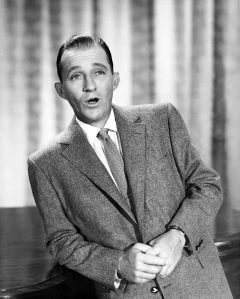 This 1945 song, composed by Jule Styne with lyrics by Sammy Cahn, became a major hit at the end of World War Two, written from the perspective of someone welcoming home his significant other at the end of the war. A recording by Harry James and his band went to #1 on the Billboard Hot 100 on November 24, 1945 while another version by Bing — accompanied by The Les Paul Trio — was also working its way up the charts. Bing’s record replaced Harry James’ version at No. 1 on December 8, 1945. By the way, this is the kind of guitar style that my first guitar teacher, no doubt a big Les Paul fan, tried to teach 12-year old me when I only wanted to rock. Like Bing, Les Paul makes all his brilliance, tuneful, tasteful phrasing and dazzling chops sound so effortless.
This 1945 song, composed by Jule Styne with lyrics by Sammy Cahn, became a major hit at the end of World War Two, written from the perspective of someone welcoming home his significant other at the end of the war. A recording by Harry James and his band went to #1 on the Billboard Hot 100 on November 24, 1945 while another version by Bing — accompanied by The Les Paul Trio — was also working its way up the charts. Bing’s record replaced Harry James’ version at No. 1 on December 8, 1945. By the way, this is the kind of guitar style that my first guitar teacher, no doubt a big Les Paul fan, tried to teach 12-year old me when I only wanted to rock. Like Bing, Les Paul makes all his brilliance, tuneful, tasteful phrasing and dazzling chops sound so effortless.
23. Nice And Easy (Frank)
The song’s title says it all. Frank recorded this tune, written by Lew Spence/Alan Bergman/Larry Keith, for his 1960 album of the same name. Arranged and conducted by Nelson Riddle. (Have I heard that somewhere before?)
24. You’re Nobody ‘Til Somebody Loves You (Dean)
 Another dreamboat Dino song on the St. Rocco’s Labor Day Festival hit parade. Written by Russ Morgan, Larry Stock and James Cavanaugh and published in 1944, the song was first recorded by Morgan himself – but the best known version is by Dean, who recorded it for his 1964 album, “The Door Is Still Open to My Heart”. It reached #24 on the US pop chart, #1 on the easy listening chart — and #1A on the St. Rocco’s PA pop chart – next to “Volare” (1B) and “Everybody Loves Somebody” (1C).
Another dreamboat Dino song on the St. Rocco’s Labor Day Festival hit parade. Written by Russ Morgan, Larry Stock and James Cavanaugh and published in 1944, the song was first recorded by Morgan himself – but the best known version is by Dean, who recorded it for his 1964 album, “The Door Is Still Open to My Heart”. It reached #24 on the US pop chart, #1 on the easy listening chart — and #1A on the St. Rocco’s PA pop chart – next to “Volare” (1B) and “Everybody Loves Somebody” (1C).
25. Nice Work If You Can Get It (Bing)
 Bing recorded this George & Ira Gershwin classic for his 1956 album, “Bing Sings Whilst Bregman Swings” – a collaboration between Bing and Buddy Bregman. At the time, Bregman was a 26-year old wunderkind arranger, record producer and composer. Bing was 53. (53? Yikes! That’s younger than I am!) The album was a stylistic departure for Bing: the first time he recorded an album with a hard-swinging orchestra like Frank was doing with Nelson Riddle at the same time. The songs on the album were among the rare few that Bing had never recorded before. Besides coming up with the idea of the album, Bregman also did the orchestrations and conducted a handpicked group of Hollywood’s best musicians to back Bing in the studio. The Variety reviewer wrote, “Altogether it is quite a musical package – muscular and tender, driving and romantic, pulsating and lyrical. For Bing Crosby, the artist, it is a somewhat different testament to add to the many already on record and, as you will hear, an ingeniously varied and durable one.” Time Magazine said, “After 22 years of making records for Decca — plus a few before even Decca latched onto him — Bing Crosby steps out with a handful of oldies on a new label, proves himself virtually indestructible.” Nice work if you can get it.
Bing recorded this George & Ira Gershwin classic for his 1956 album, “Bing Sings Whilst Bregman Swings” – a collaboration between Bing and Buddy Bregman. At the time, Bregman was a 26-year old wunderkind arranger, record producer and composer. Bing was 53. (53? Yikes! That’s younger than I am!) The album was a stylistic departure for Bing: the first time he recorded an album with a hard-swinging orchestra like Frank was doing with Nelson Riddle at the same time. The songs on the album were among the rare few that Bing had never recorded before. Besides coming up with the idea of the album, Bregman also did the orchestrations and conducted a handpicked group of Hollywood’s best musicians to back Bing in the studio. The Variety reviewer wrote, “Altogether it is quite a musical package – muscular and tender, driving and romantic, pulsating and lyrical. For Bing Crosby, the artist, it is a somewhat different testament to add to the many already on record and, as you will hear, an ingeniously varied and durable one.” Time Magazine said, “After 22 years of making records for Decca — plus a few before even Decca latched onto him — Bing Crosby steps out with a handful of oldies on a new label, proves himself virtually indestructible.” Nice work if you can get it.
26. One For My Baby (And One More For The Road) (Frank)
 Frank first recorded this boozy lament, written by Johnny Mercer and Harold Arlen, for his melancholy masterpiece LP, Only The Lonely” in 1958. Eight years later, he recorded this live version at The Sands in Las Vegas with Count Basie and The Orchestra, arranged and conducted by Quincy Jones. I can’t think of a better way to wrap up this post. Set ‘em up, Frank. Let’s hear one more for the road.
Frank first recorded this boozy lament, written by Johnny Mercer and Harold Arlen, for his melancholy masterpiece LP, Only The Lonely” in 1958. Eight years later, he recorded this live version at The Sands in Las Vegas with Count Basie and The Orchestra, arranged and conducted by Quincy Jones. I can’t think of a better way to wrap up this post. Set ‘em up, Frank. Let’s hear one more for the road.









Wow, Paul — I had no idea you knew your way around these guys. I’m a pretty big Bing fan and have a good amount of his early stuff, but I needed some convincing and it took me a while to get there. Gary Giddins, one of my all-time favorite jazz and movie critics has written the first part of a masterful Bing biography. (He’s working on part two now.) I watched him work a room full of skeptics at Book Soup very hard who were stuck in the belief of what a bad guy he was because of a book by one of his children and his association with Florida Orange Juice! As with many singers of this era, I like the early stuff, and Gary turned me on to the CD “Bing Crosby, Jazz Singer, 1931-1941,” and I heartily recommend it. Though I used to be insulted when he steps in front of Louis Armstrong in “High Society” and starts singing about jazz in front of the greatest jazz singers of all, I now know he was good friends and a big backer of Armstrong.
And though I think “Fly Me to the Moon” one of the greatest songs ever recorded, I still have a hard time with Frank because he’s Frank. My vote for greatest phrasing by a male voice, an issue I continually harp on, is George Jones.
Thanks, Paul!
Love Deano. FYI, Deano always said his style was influenced by The Mills Brothers. I forget which one in particular. Love the way you can hear Deano smile when he sings, as Elvis said, Dean Martin wears the King Of Cool crown, man.
Paul, I think I got a feeling of what I may be getting in the mail soon. And since you gots mine, I knows you have already heard the Deano song I sent, from This Time I’m Swingin’. Deano’s 1957’s Pretty Baby LP also gets heavy airplay from me.
(Oh, and as far as comedians, Deano is numero no for me, followed by Bing, then Frank. If you ever get a chance to see Martin and Lewis from their TV hey day before their movies took off you will see amazing anarchy comedy with Deano in perfect step with Jerry. Deano is being subtle, and on the mark, AND at times as way out as Jerry Lewis. As I watched Jerry in the 60’s then later Jerry and Deano’s earlier movies and kept hearing him talk from 60’s until now, I could admire his some of his mastery, but I found him a tad off-putting, however, on those early TV shows, Jerry is brilliant and so is Deano)
Great thank you
Hi Paul,
Belatedly, just found your excellent piece on Bing and the boys…
I’d read of John Lennon’s fascination with Bing’s “Please,” but had no idea of his affinity for ‘Bing With A Beat’; one of my own (Bing) favourites.
Long story, but, way back in May 2006, I self-produced what turned out to be Buddy Bregman’s very last studio sessions, at Westlake Recording Studios – L.A
(See my recent update to the Buddy Bregman Wikipedia page, under the pen name Maskom H. – https://en.wikipedia.org/wiki/Buddy_Bregman )
All kindest regards from the UK,
Tom